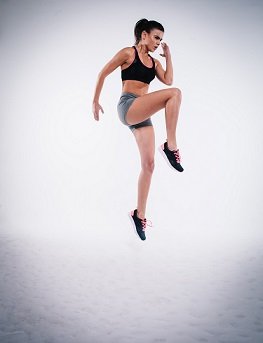The fact that you’re here means you’re looking for good leg workouts, which means you actually train or at least plan to train your lower body, which makes you a rare breed (if you’re a guy, at least). Unlike women, most men rarely train their legs as much as they should. I propose you something:
Stand in front of a mirror and drop your pants. Do you like what you see? No? The same thing happened to me, I know that feeling.

That is why I am here to help you and I have created this guide where you will find everything that science tells us about what is the best exercise routine for legs and how to make them look strong and defined whether you are a man or a woman.
Leg Anatomy, Why Is It Important To Know It?
If you are looking to improve the condition and musculature of your legs, it is important that you first understand and know its anatomy and function.
The legs have a complex structure and allow us, among other things, to move, stand upright and perform various movements. Many of the things we do every day depend on them.
That is why keeping them in good condition and strengthening them is very important for the health of our body. Even more so if you are interested in improving your physical performance.
The leg is the segment between the hip and the ankle. It is made up of bones, tendons, ligaments, and muscles.

What Muscles Make Up The leg workouts?
The muscles that make up the leg workouts are divided into two sections, upper and lower. The main and most important are:
Buttocks
It is a very powerful, voluminous and strong muscle group. They span from the pelvis to the back of the femur.
It is made up of the gluteus maximus, gluteus medius, and gluteus minimus.
They are in charge of:
- Maintain upright hip posture.
- Provide the force to bring the thigh backwards.
Quadriceps
This group of muscles along with the glutes are one of the largest, strongest and heaviest in our body.
The quads are located in the front thigh and run from the hip to the knee.
They are composed of four parts: vastus medial, vastus lateralis, vastus intermedius, and rectus femoris.
It will permit you:
- Extend the hip.
- Flex the knee.
- Stabilize the patella.
Adductors
This group consists of the adductor brevis, adductor longus, and adductor magnus. It covers from the inner part of the thigh to the pubis.
This group’s mission is to provide stability to the pelvis and knee when you perform any physical activity. It achieves this precisely with its adduction function, which consists of bringing the thigh closer to the center of the body.
Gastrocnemius
This group formed by the gastrocnemius and the soleus give shape to the calf. They begin their journey in the upper part of the fibula and inside the tibia until they insert into the Achilles tendon.
The most important functions of this group are:
Give stability to the knee joint.
Ankle extension.
Keep the lower limbs upright when standing or moving.
Femoral
It is a group of three muscles that originates in the hip, passes through the thigh, the knee, and inserts into the upper leg bones.
It is made up of the biceps femoris, semitendinosus, and semimembranosus. The task of this muscle group is:
Allow thigh extension.
- Generates knee flexion.
- Tensor Fasciae Latae
This muscle is located on the lateral side of the thigh and extends from the pelvis to the bottom of the knee.
It is a long muscle that has the following functions:
- Move thigh out.
- Flex the hip.
- Leg Muscles. Functions.
Something important that you should know when planning your training is the function that the muscles have depending on the movement they perform.
Thus we find that the muscles are divid into:
Agonist Muscles
They are responsible for providing the main force to complete the movement. They are known as the main muscles.
Antagonist Muscles
They are the ones that oppose the agonist making a contrary movement. They relieve the main muscle and allow its movement.
Synergistic Or Stabilizing Muscles
Its function is to stabilize the joint involved in the movement performed. This in turn helps the main muscle to work better.